Ojai, California
Ojai (/ˈoʊhaɪ/ OH-hy) is a city in Ventura County in the U.S. state of California. Located in the Ojai Valley, it is northwest of Los Angeles and east of Santa Barbara. The valley is part of the east–west trending Western Transverse Ranges and is about 10 miles (16 km) long by 3 miles (5 km) wide and divided into a lower and an upper valley, each of similar size, surrounded by hills and mountains. The population was 7,461 at the 2010 census, down from 7,862 at the 2000 census.
Ojai, California | |
|---|---|
City | |
| City of Ojai | |
.jpg) _(cropped).jpg) _(cropped).jpg) Clockwise: Ojai Valley Museum; U.S. Post Office; Ojai Arcade; Aerial View of Ojai. | |
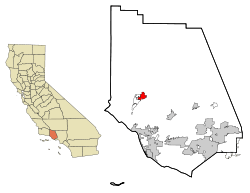 Location in Ventura County and the state of California | |
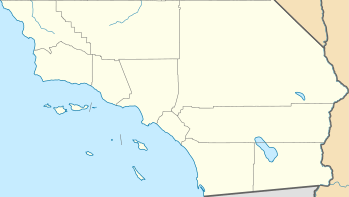 Ojai Location of Ojai in Southern California  Ojai Location of Ojai in California  Ojai Location of Ojai in the United States | |
| Coordinates: 34°26′57″N 119°14′48″W | |
| Country | |
| State | |
| County | Ventura |
| Incorporated | August 5, 1921[1] |
| Named for | Chumash: 'Awha'y ("Moon")[2] |
| Government | |
| • Type | City Council—City Manager[3] |
| • Mayor | Johnny Johnston [4] |
| • State senator | Hannah-Beth Jackson (D)[5] |
| • Assembly member | Monique Limón (D)[5] |
| • U. S. rep. | Julia Brownley (D)[6] |
| Area | |
| • Total | 4.37 sq mi (11.32 km2) |
| • Land | 4.36 sq mi (11.28 km2) |
| • Water | 0.01 sq mi (0.04 km2) 0.35% |
| Elevation | 745 ft (227 m) |
| Population | |
| • Total | 7,461 |
| • Estimate (2019)[10] | 7,470 |
| • Density | 1,714.88/sq mi (662.13/km2) |
| Time zone | UTC−8 (Pacific) |
| • Summer (DST) | UTC−7 (PDT) |
| ZIP codes | 93023 & 93024 |
| Area code | 805 |
| FIPS code | 06-53476 |
| GNIS feature IDs | 1652763, 2411308 |
| Website | ojaicity |
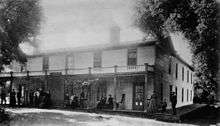
.jpg)
Ojai is a tourism destination known for its boutique hotels, recreation opportunities, hiking, spiritual retreats and farmers' market of local organic agriculture.[11] It has small businesses specializing in local and ecologically friendly art, design, and home improvement. Chain stores are prohibited by city ordinance to encourage local small business development and keep the town unique.
The name Ojai is derived from the Ventureño Chumash word 'Awha'y, meaning moon.[12][13][14] The city's self-styled nickname is "Shangri-La" referencing the natural environment of this health and spirituality-focused region as well as the mystical sanctuary of the 1937 film adaptation of James Hilton's novel Lost Horizon.[15]
History
Chumash
The Chumash are a Native American people who inhabited the central and southern coastal regions of California, in portions of what are now Morro Bay in the north to Malibu in the south and the Channel Islands. Chumash Indians were the early inhabitants of the Ojai Valley. The name Ojai is derived from the Ventureño Chumash word ʼawha'y meaning "moon."[12][13][14] A 1905 book on place names in the United States records the name Ojai as being derived from an Indigenous word meaning "nest", though the specific Indigenous nation is not identified.[16]
Rancho Ojai
In 1837, Fernando Tico, a Santa Barbara businessman, received the 17,716-acre Rancho Ojai Mexican land grant, which included both the lower and upper Ojai valleys. Tico operated a cattle ranch on the land and moved his large family to an adobe in the lower valley. Tico sold the entire Rancho Ojai in 1853.[17] The rancho changed hands several more times before it was purchased in 1864 by Thomas A. Scott, a Pennsylvania oil and railroad baron. The petroleum exploration of the Ojai Basin was the result of a report of oil seeps (oil springs) along the Sulphur Mountain area. In 1866, Scott's nephew Thomas Bard used a steam-powered cable-tool drilling rig on the north side of Sulphur Mountain. On May 29, 1867, Ojai No. 6 produced an oil gusher, at a depth of 550 feet, and the Ojai Field eventually produced 10-20 barrels of oil a day. Also in 1866, Leland Stanford's brother Josiah dug oil tunnels on the south side of Sulphur Mountain, producing 20 barrels a day for the Stanford Brothers refinery in San Francisco. For economic reasons, falling oil prices at the end of the Civil War and cheaper imports from the east, Scott and Stanford ceased oil exploration in the valley area. Thomas Bard then began selling the surface rights to parcels of Rancho Ojai in late 1867. As the president of Unocal, Bard would return in the 1890s to dig about 50 oil tunnels into Sulphur Mountain, which produced until 1998.[18][19][20]
Nordhoff
The town was laid out in 1874[21] by San Buenaventura businessman R.G. Surdam and named Nordhoff in honor of the writer Charles Nordhoff who had written a book about California titled, California for Health, Pleasure and Residence: A Book for Travelers and Settlers. Most early settlers to the valley had one or more family members who were ill, particularly with respiratory illnesses, and the Ojai Valley developed a reputation for having healthy air quality. Many did get well after moving to the valley. Charles Nordhoff had not visited the Ojai Valley when his book came out in 1873, but made several visits to his namesake town in the early 1880s, and he mentioned the Ojai Valley in the revised 1882 version of his popular book.[22] The discovery of hot springs in Matilija Canyon and subsequent development of hot springs resorts in the late 1800s contributed to the valley's healing mystique.
The public high school in Ojai is still named Nordhoff High School. The public junior high school, named "Matilija", formerly served as Nordhoff Union High School and still features large tiles with the initials "NUHS" on the steps of the athletic field.
Railroad
The Ventura and Ojai Valley Railroad connected Ojai to the national rail network near Ventura station in 1898.[23] The Southern Pacific Railroad acquired all the capital stock in the Ventura and Ojai Valley Railroad in April 1898.[24] A nine-day Pineapple Express with rainfall intensity reaching 6.2 inches (16 cm) per day caused floods destroying the rail line in January 1969.[25] The former rail line was converted to the Ojai Valley Trail in 1989.[26]
Libbey
Nordhoff became a popular wintering spot for wealthy Easterners and Midwesterners. The elite Foothills Hotel, which catered to them, was built on a mountain overlooking the town in 1903. Visitors enjoyed dining, music concerts, horseback riding, and hunting and fishing trips into the back country. Some of these businessmen built homes in the valley and contributed to the community's development. Among these winter visitors were Edward Drummond Libbey and his wife Florence. Their first winter in Ojai was in 1907. Libbey was the owner of the Libbey Glass Company of Toledo, Ohio. He fell in love with the valley, bought property in the Foothills tract in 1909, and built a Craftsman-style house designed by Myron Hunt and Elmer Grey.[27]
Steeped in City Beautiful ideals, Libbey began thinking about what could be done to beautify the existing rustic town. He bought up all the properties on the south side of Ojai Avenue (where Libbey Park is today) and most of the buildings there were demolished. In 1916, he hired the architectural firm of Frank Mead and Richard Requa of San Diego to transform Nordhoff into the Spanish-style town center seen today. The project included a Mission-style arcade along the main street, a bell-tower reminiscent of the famous campanile of the Cathedral of the Virgin Mary of the Immaculate Conception in Havana, Cuba (also known as the Havana Cathedral), and a pergola with two arches opposite the arcade. In March 1917, just after completion of the renovation project, the name of the town was changed to Ojai. The valley had always been known as "The Ojai" and it made sense with the town's new image to change its name as well.[28]
Leading up to and during World War I, American sentiment became increasingly anti-German. Across the United States, German and German-sounding place names were changed. Some Ojai writers in the past have speculated that anti-German sentiment contributed to the name change of Nordhoff to Ojai in 1917.[29][30] There is no clear evidence that this was the case for the name change in Ojai.
To thank Libbey for his gifts to the town, the citizens proposed a celebration in the new Civic Center Park (later changed to Libbey Park) that they wished to call "Libbey Day," but Libbey suggested "Ojai Day" instead. The first Ojai Day took place April 7, 1917.[31] Ojai Day was celebrated each year until 1928. Local schoolteacher Craig Walker revived Ojai Day in 1991 and it has been celebrated since.[32] The Ojai Day celebration takes place in October.
In 1917 two fires struck the community. The first started in Matilija Canyon on June 16 and burned 60 buildings in its path, including many homes and the Foothills Hotel. The newly Spanish-style structures in the downtown were not affected. On November 28, 1917, a fire started in a gasoline stove in a store in the Arcade and the stores in the western half of the Arcade burned down. Part of the Arcade suffered smoke damage but did not burn down.[33] A new Spanish-style Foothills Hotel was built in 1919–1920 to replace the one that burned down.
The Taormina neighborhood was established as the first historic district in the city in 2016. The housing development was built in the style of French architecture of Normandy in the 1960s and 1970s by members of the Theosophy movement adjacent to the Krotona Institute of Theosophy. Taormina's founder, theosophist Ruth Wilson, envisioned the development as a retirement community for fellow theosophists but in the early 1980s a court ruling required the community to be open to residents of all faiths and backgrounds.[34]
Geography
Ojai is situated in a small east–west eponymous valley, north of Ventura and east of Santa Barbara.[35] The city is approximately 745 feet (227 m) above sea level and borders the Los Padres National Forest to the north.[36] It is approximately 15 miles (24 km) inland from the Pacific Ocean. The Ojai Valley lies within the Topa Topa Mountains on the north and south and is actively shaped by a web of earthquake faults.[35] The Santa Ynez Mountains lie to the north, while Sulphur Mountain and the lower Black Mountain lie to the south. The mountains to the west of the Ojai Valley are drained by the Coyote, Matilija and Santa Ana creeks. These empty into the Ventura River. The Matilija Dam, Casitas Dam and Lake Casitas Reservoir alter the historic drainage of these creeks and the river. The creeks that drain the mountains directly north of Ojai empty into San Antonio Creek, as does Lion Canyon Creek that lies between Black Mountain and Sulphur Mountain. San Antonio Creek drains into the Ventura River just north of Casitas Springs. The Ventura River flows through the Ventura River Valley and empties into the Pacific Ocean at the city of Ventura.[37] The Ventura River was once known for its steelhead fishing before Matilija Dam and Lake Casitas were constructed, eliminating habitat for this trout species.
The eastern part of the Upper Ojai Valley is drained by the Sisar and Santa Paula creeks. These creeks flow into the Santa Clara River at Santa Paula. The high mountains above the Ojai Valley and further east are drained by Sespe Creek, which empties into the Santa Clara River at Fillmore. In 1991, 31.5 miles of the 55-mile-long Sespe Creek was given federal Wild & Scenic River status.[38]
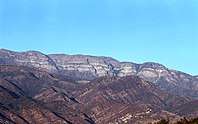
Nordhoff Ridge, the western extension of the Topatopa Mountains, towers over the north side of the valley at more than 5,000 feet (1,500 m). Sulphur Mountain creates the southern ranges bounding the Ojai Valley, a little under 3,000 feet (910 m) in elevation. The Sulphur and Topatopa mountains are part of the Transverse Ranges system. The Ojai Valley and the surrounding mountains are heavily wooded with oak trees.[39]
Climate
The climate of Ojai is Mediterranean, characterized by hot, dry summers, at times exceeding 100 °F or 37.8 °C, and mild, rainy winters, with lows at night falling below freezing at times. During dry spells with continental air, morning temperatures, due to Ojai's valley location, can drop well below most of Southern California, with the record being 13 °F (−10.6 °C) on January 6 and 7 of 1913. In contrast, Ojai is far enough from the sea to minimize marine cooling, and very hot days can occur during summer, with the record being 119 °F (48.3 °C) on June 16, 1917 – when it fell as low as 65 °F (18.3 °C) in the morning due to clear skies and dry air.
As is typical for much of coastal southern California, most precipitation falls in the form of rain between the months of October and April, with intervening dry summers. As with all of Southern California, rain falls on few days, but when it does rain it is often extremely heavy: the record being 9.05 inches (229.9 mm) on February 24, 1913, followed by 8.15 inches (207.0 mm) on January 26, 1914. During the wettest month on record of January 1969, 25.76 inches or 654.3 millimetres fell, with a whopping 23.46 inches (595.9 mm) in eight days from January 19 to January 26. In contrast, the median annual rainfall for all years in Ojai is only around 18.1 inches or 460 millimetres and in the driest "rain year" from July 2006 to June 2007, just 6.87 inches or 174.5 millimetres fell in twelve months. The wettest "rain year" was from July 1997 to June 1998 with 48.29 inches (1,226.6 mm).
| Climate data for Ojai, California (1971-2000, extremes since 1905) | |||||||||||||
|---|---|---|---|---|---|---|---|---|---|---|---|---|---|
| Month | Jan | Feb | Mar | Apr | May | Jun | Jul | Aug | Sep | Oct | Nov | Dec | Year |
| Record high °F (°C) | 91 (33) |
92 (33) |
98 (37) |
104 (40) |
105 (41) |
119 (48) |
117 (47) |
115 (46) |
114 (46) |
108 (42) |
100 (38) |
94 (34) |
119 (48) |
| Average high °F (°C) | 68.1 (20.1) |
69.2 (20.7) |
70.2 (21.2) |
75.0 (23.9) |
77.5 (25.3) |
83.5 (28.6) |
88.9 (31.6) |
90.1 (32.3) |
87.2 (30.7) |
81.9 (27.7) |
74.3 (23.5) |
69.3 (20.7) |
77.9 (25.5) |
| Average low °F (°C) | 36.9 (2.7) |
39.6 (4.2) |
41.7 (5.4) |
44.0 (6.7) |
48.4 (9.1) |
52.4 (11.3) |
55.7 (13.2) |
55.9 (13.3) |
53.6 (12.0) |
47.3 (8.5) |
39.9 (4.4) |
35.8 (2.1) |
45.9 (7.7) |
| Record low °F (°C) | 13 (−11) |
22 (−6) |
25 (−4) |
27 (−3) |
31 (−1) |
34 (1) |
40 (4) |
39 (4) |
37 (3) |
27 (−3) |
23 (−5) |
16 (−9) |
13 (−11) |
| Average rainfall inches (mm) | 4.81 (122) |
5.68 (144) |
4.36 (111) |
1.04 (26) |
0.48 (12) |
0.08 (2.0) |
0.03 (0.76) |
0.08 (2.0) |
0.41 (10) |
0.57 (14) |
1.46 (37) |
2.79 (71) |
21.79 (551.76) |
| Average rainy days (≥ 0.01 inch) | 6.4 | 6.2 | 6.8 | 2.9 | 1.6 | 0.6 | 0.3 | 0.3 | 1.2 | 2.0 | 3.2 | 4.3 | 35.8 |
| Source: [40] | |||||||||||||
Demographics
| Historical population | |||
|---|---|---|---|
| Census | Pop. | %± | |
| 1930 | 1,468 | — | |
| 1940 | 1,622 | 10.5% | |
| 1950 | 2,519 | 55.3% | |
| 1960 | 4,495 | 78.4% | |
| 1970 | 5,591 | 24.4% | |
| 1980 | 6,816 | 21.9% | |
| 1990 | 7,613 | 11.7% | |
| 2000 | 7,862 | 3.3% | |
| 2010 | 7,461 | −5.1% | |
| Est. 2019 | 7,470 | [10] | 0.1% |
| U.S. Decennial Census[41] | |||
2010
The 2010 United States Census[42] reported that Ojai had a population of 7,461. The population density was 1,695.3 people per square mile (654.6/km2). The racial makeup of Ojai was 6,555 (87.9%) White, 42 (0.6%) African American, 47 (0.6%) Native American, 158 (2.1%) Asian, 1 (0.0%) Pacific Islander, 440 (5.9%) from other races, and 218 (2.9%) from two or more races. Hispanic or Latino of any race were 1,339 persons (17.9%).
The Census reported that 7,281 people (97.6% of the population) lived in households, 48 (0.6%) lived in non-institutionalized group quarters, and 132 (1.8%) were institutionalized.
There were 3,111 households, out of which 876 (28.2%) had children under the age of 18 living in them, 1,396 (44.9%) were opposite-sex married couples living together, 366 (11.8%) had a female householder with no husband present, 128 (4.1%) had a male householder with no wife present. There were 151 (4.9%) unmarried opposite-sex partnerships, and 25 (0.8%) same-sex married couples or partnerships. 992 households (31.9%) were made up of individuals, and 496 (15.9%) had someone living alone who was 65 years of age or older. The average household size was 2.34. There were 1,890 families (60.8% of all households); the average family size was 2.95.
The population distribution was spread out, with 1,520 people (20.4%) under the age of 18, 515 people (6.9%) aged 18 to 24, 1,446 people (19.4%) aged 25 to 44, 2,547 people (34.1%) aged 45 to 64, and 1,433 people (19.2%) who were 65 years of age or older. The median age was 47.1 years. For every 100 females, there were 84.9 males. For every 100 females age 18 and over, there were 79.9 males.
There were 3,382 housing units at an average density of 768.5 per square mile (296.7/km2), of which 1,717 (55.2%) were owner-occupied, and 1,394 (44.8%) were occupied by renters. The homeowner vacancy rate was 1.7%; the rental vacancy rate was 5.4%. 4,243 people (56.9% of the population) lived in owner-occupied housing units and 3,038 people (40.7%) lived in rental housing units.
2000
As of the census[43] of 2000, there were 7,862 people, 3,088 households, and 1,985 families residing in the city. The population density was 1,773.0 people per square mile (685.2/km2). There were 3,229 housing units at an average density of 728.2 per square mile (281.4/km2). The racial makeup of the city was 88.01% White, 0.60% African American, 0.50% Native American, 1.58% Asian, 0.17% Pacific Islander, 6.26% from other races, and 2.90% from two or more races. Hispanic or Latino of any race were 15.84% of the population.
There were 3,088 households, out of which 31.7% had children under the age of 18 living with them, 49.0% were married couples living together, 11.6% had a female householder with no husband present, and 35.7% were non-families. 29.0% of all households were made up of individuals, and 13.9% had someone living alone who was 65 years of age or older. The average household size was 2.48 and the average family size was 3.06.
In the city, the population was spread out, with 24.9% under the age of 18, 6.5% from 18 to 24, 23.9% from 25 to 44, 26.8% from 45 to 64, and 17.9% who were 65 years of age or older. The median age was 42 years. For every 100 females, there were 88.5 males. For every 100 females age 18 and over, there were 83.2 males.
The median income for households in the city was $44,593, and the median income for a family was $52,917. Males had a median income of $40,919 versus $30,821 for females. The per capita income for the city was $25,670. About 7.9% of families and 10.7% of the population were below the poverty line, including 15.9% of those under age 18 and 9.3% of those age 65 or over.
Economy
Chain stores are prohibited by city ordinance to encourage local small business development and keep the town unique.[44][45]
Cannabis
Under the legalization of the sale and distribution of cannabis in California, Ojai is one of two cities in the county to allow retail sales. State law says local governments may not prohibit adults from growing, using or transporting marijuana for personal use but they can prohibit companies from growing, testing, and selling cannabis within their jurisdiction by licensing none or only some of these activities. By the end of 2018, three recreational marijuana storefronts were open in close proximity to each other.[46]
Culture

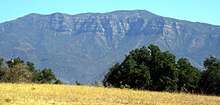
Ojai's culture is heavily focused on ecology, health and organic agriculture, walking/hiking, spirituality, music and local art.[47][48] Weekends may include exhibiting classic cars or motorcycle clubs touring the area.[49] On July 8, 1999, former Apollo astronaut Pete Conrad, one of the twelve men who walked on the moon, died of injuries suffered from a motorcycle accident in Ojai.[50]
The Ojai Music Festival (founded in 1947) is an annual festival of performances by some of the world's top musicians and composers, and occurs on the first weekend after Memorial Day. Notable appearances include Igor Stravinsky, Aaron Copland, Esa-Pekka Salonen and Pierre Boulez, who was festival director in 2003. The outdoor bookshop Bart's Books, subject of news programs and documentaries, has been in Ojai since 1964. Ojai is home to the annual Ojai Playwrights Conference, a two-week playwrights festival that brings professional writers and actors from across the country to Ojai. The community is served by the Ojai Valley News, a weekly newspaper, the Ojai Valley Guide (formerly the Ojai Valley Visitors Guide) and the Ojai Quarterly, magazines published every 3 months.
In early June, often coinciding with the Music Festival, the Ojai Wine Festival is held at Lake Casitas. Over 3,000 wine lovers sample the products of over 30 wineries. Proceeds go to charity.
Parks and recreation
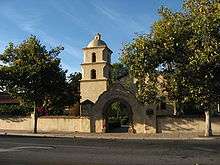
The town of Ojai and its surrounding area is home to many recreational activities. Los Padres National Forest borders the town on the north, and many back country areas within the forest are accessible from Highway 33, the major north–south highway through town. Matilija Creek is a spot to enjoy splashing under waterfalls and backpacking. To the west, the Lake Casitas Recreation Area offers camping, picnicking, hiking, boating, fishing, and has a water park. No swimming or body contact is allowed in Lake Casitas.
The valley has several public tennis courts in downtown Libbey Park. There are also two major golf courses: the Soule Park Golf Course, and the noted Ojai Valley Inn Golf Course. The town completed a new park, Cluff Vista Park, in 2002, which contains several small themed regions of California native plants, two water features, and three public art works. The park is located on a small hill which has a great view of the mountains surrounding the town.
Sarzotti Park is a 10-acre (4.0 ha) city park that is home to the City of Ojai Recreation Center. The center was formerly the Boyd Clubhouse which was built in 1903 and located on the south side of Ojai Avenue east of Libbey Park. The Boyd Club was a men's athletic and activity club. The Boyd clubhouse was moved to Sarzotti Park in 1957. the city's recreational program offers soccer, softball, football, basketball, tennis, volleyball, exercise programs, and many other classes. The Ojai Recreation Department publishes an activity guide several times a year.
In April, "The Ojai" tennis tournament is held. It is the oldest tennis tournament west of the Mississippi River (founded in 1896) and has been an early competition for many players who went on to earn one or more Grand Slam titles. The Wall of Fame in Libbey Park honors players who competed in "The Ojai" and went on to win at least one Grand Slam.[51] The tournament holds amateur competitions for boys and girls and Pacific-10 (now Pac-12) competitions. William Thacher (brother of Sherman Thacher) founded the Ojai Valley Tennis Club in 1895 and this group has been organizing "The Ojai" tennis tournament ever since. The group began sponsoring tennis competitions in 1896 and they use this date as the beginning of "The Ojai." There were five years when the tournament was not held: 1924 because of a hoof-and-mouth epidemic and from 1943 to 1946 during and just after World War II.[52]
Ventura County parks in the area include Foster Park near Casitas Springs, Camp Comfort on Creek Road, Soule Park and Soule Park Golf Course, and Dennison Park on the Dennison Grade.
Annually, in early April, the town hosts a bicycle race that draws professional and amateur teams from around the country. The "Garrett Lemire Memorial Grand Prix" began in 2004 as a tribute to a 22-year-old cyclist from Ojai who died racing his bicycle in Arizona the previous year. The race is held on a 1 mile (1.6 km) circuit that circumnavigates Libbey Bowl in the heart of downtown Ojai. Proceeds from event promote cycling safety and education in local schools.[53]
Public safety
Law enforcement
The Ventura County Sheriff's Office provides law enforcement services for the city. No homicides were recorded in 2015–2018.[54][55]
Education
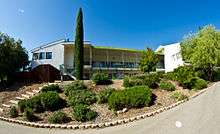
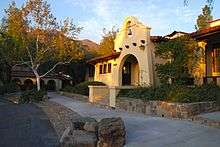
Public schools
- Ojai Unified School District
- Chaparral High School
- Nordhoff High School
- Matilija Junior High School
- Meiners Oaks Elementary School
- Mira Monte Elementary School
- San Antonio School
- Summit Elementary School
- Topa Topa Elementary School[56]
- Matilija Junior High School
- Valley Oak Charter School
Other schools
The Ojai Valley is home to several private boarding schools:
- Besant Hill School of Happy Valley (formerly Happy Valley School)
- The Thacher School
- Ojai Valley School
- Villanova Preparatory School
- Oak Grove School
- Weil Tennis Academy
- Monica Ros School (preschool through 3rd grade)
- The Ojai Valley is also home to: the Montessori School of Ojai, a private day school, Laurel Springs School, which specializes in distance education and home-schooling, Rock Tree Sky School, a K-12 self-directed homeschooling program in upper Ojai, and Global Village School, a progressive K–12 homeschooling program.
- Camp Ramah in California is in the hills of Ojai.
The Summer Science Program was formerly hosted at the Besant Hill School (2000–2009) and at The Thacher School (1959–1999).
Media
The Ojai Valley News is a weekly, community-oriented newspaper that has been published since Oct. 27, 1891. The newspaper was called The Ojai until 1958. A newspaper called The Ojai Valley News was founded in competition to The Ojai in 1949. In 1958, J. Frank Knebel bought The Ojai, The Ojai Valley News and another small paper called The Oaks Gazette. He called this combined paper the Ojai Valley News and Oaks Gazette. A competition newspaper called The Ojai Press was founded in 1959 and another called The Oaks Sentinel came out the following year. When both of these papers floundered a group of over 100 people called "Voice of the Valley" pitched in to take over these papers and began publishing the Press Sentinel. Members of the Voice of the Valley group felt strongly that there needed to be an alternative viewpoint in the valley from the views expressed in Knebel's paper. The Press Sentinel was published for two years. When Fred Volz purchased The Ojai Valley News and Oaks Gazette in 1962, changing the name to Ojai Valley News, the Press Sentinel ceased publication.[57]
The staff of the Ojai Valley News also publishes the weekly Ojai Valley Real Estate Guide, its daily news website ojaivalleynews.com and the quarterly general-interest magazine, the Ojai Valley Guide (formerly the Ojai Valley Visitors Guide).
Infrastructure
Water
In 2013, a plan to take over the private water system was approved by voters. Up to $60 million in bonds would be issued and a special tax district would be formed. This was approved by almost 90 percent of voters but it was tied up in court by the private water purveyor, Golden State Water Company.[58] Casitas Municipal Water District took over management of the Ojai water system by purchase of the franchise from Golden State Water Company in April 2017. The Ojai Valley Sanitary District treats the sewage from the city and surrounding areas.[59]
Libraries
Public libraries: Ventura County Library—14 county locations, with three branches in the Ojai Valley:
In popular culture
Ojai is the setting for the 2010 comedy film Easy A (much of which was shot on location), and for part of Michael Scott's book The Alchemyst: The Secrets of the Immortal Nicholas Flamel. Ojai is the location of the fruit orchards of the fictional Ojai Foods, central to the conflict and drama of the Walker family in the ABC series Brothers & Sisters.
The title characters of the TV series The Bionic Woman and The Six Million Dollar Man (Jaime Sommers and Col. Steve Austin) are described in the series as having been childhood sweethearts in Ojai. In these series, a sign on the highway entering Ojai reads "Welcome to Ojai, home of American astronaut Steven Austin."[63] In The Bionic Woman, Jaime Sommers makes her home in Ojai and thus many episodes of that series, in whole or in part, take place there. Sommers works as a schoolteacher at the fictional Ventura Air Force Base, which is depicted as being close to Ojai.
In the 1990 movie Hard to Kill, Mason Storm, played by Steven Seagal, was brought to Ojai to flee his enemies, and track 8 on the soundtrack from David Michael Frank is called Escape From Ojai.
Ojai is also the city in which the character of Jake Hanson (played by Grant Show) buys a restaurant and relocates to after leaving Los Angeles in the final season of the TV series Melrose Place.
Notable people
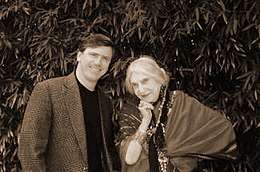
- Bud Abbott, actor, producer, and comedian
- Beth Allen, professional golfer
- David Allen, author, Getting Things Done
- June Allyson, actress
- Colman Andrews, writer and editor
- Ethel Percy Andrus, founder of AARP
- Sergio Aragonés, cartoonist
- Daniel Ash, musician
- Alan Ball, film and television writer and producer[64]
- Irene Bedard, actor, musician
- Ed Begley Jr., actor
- Max Bemis, comic book writer and lead singer of the band Say Anything
- Paul Bergmann, football player
- Elmer Bernstein, film and television composer
- Emily Blunt, actress
- Bruce Botnick, engineer and producer for The Doors
- Ingrid Boulting, artist, actress
- Pierre Bouvier, singer of Simple Plan
- Eileen Brennan, actress
- Jerry Bruckheimer, film and television producer
- Eric Burdon, singer-songwriter and actor[65]
- Tim Burton, film director [66]
- Rory Calhoun, actor
- Mario Calire, Grammy Award-winning drummer
- Julie Christensen, singer
- Julie Christie, Oscar-winning actress
- Cory Coffey, BMX rider
- Glenn Corbett, actor
- Michael Crooke, professor of strategy, consultant, former CEO Patagonia, Inc., former Navy SEAL
- Ted Danson, actor
- Anthony de Mello, spiritual leader
- John Diehl, director, actor in Stargate and The Shield
- Vernon Dvorak, meteorologist, Dvorak Technique for tropical cyclone analysis
- Dave England, Jackass star
- Peter Farrelly, film director, writer, and producer
- Maynard Ferguson, jazz musician, composer
- Joe Flanigan, actor
- Robben Ford, blues/jazz guitarist and vocalist
- Mark Frost, screenwriter and television writer[67]
- Sharon Gabet, actress
- Lindy Goetz, music manager (Red Hot Chili Peppers)
- Larry Hagman, actor in I Dream of Jeannie and Dallas
- Anne Heche, actress, director, and screenwriter
- Otto and Vivika Heino, ceramic artists, "The Pottery"
- Toby Hemingway, actor in The Covenant and Feast of Love; moved to Ojai with his mother when he was 13
- Anthony Hopkins, actor
- Richard Jefferson, Australia-based molecular biologist, open source science advocate, founder of CAMBIA
- Mikael Jorgensen, keyboardist for Wilco
- Cody Kasch, actor and SAG award winner for Desperate Housewives
- Byron Katie, founder of The Work
- Roger Kellaway, jazz pianist and composer
- Linda Kelsey, actress in Lou Grant
- Ed Kowalczyk, lead singer for Live
- John Krasinski, actor [68]
- Jiddu Krishnamurti, philosopher
- James Kyson Lee, Korean American film actor, educated at Villanova Preparatory School
- Diane Ladd, actress, writer, director nominated three times each for Emmys and Oscars
- John Langley, creator of COPS
- Harry Lauter, character actor in film and television
- Zachary Levi, actor in Chuck and Less Than Perfect
- Ted Levine, actor in The Silence of the Lambs and TV's Monk
- Larry Linville, actor in M*A*S*H
- Jackie Lomax, musician, first artist signed to Apple Records, a label started by The Beatles
- Noah Lowry, former pitcher for the San Francisco Giants
- S.A. Martinez, singer/rapper of the group 311
- Dave Mason, English musician, singer and songwriter
- Elisabeth Maurus (aka Lissie), folk-rock musician
- Orpheo McCord, drummer/percussionist for Edward Sharpe and the Magnetic Zeros
- Malcolm McDowell, actor
- Charles Millard Pratt, oil industrialist and philanthropist
- Rodney Mullen, skateboarder[69]
- Bill Paxton, actor in Aliens and Apollo 13
- Paula Jean Myers-Pope, Olympic diver
- Caspar Poyck, actor, producer, chef, speaker and psychodigestive therapist
- Anthony Quinn, actor, painter, and writer
- Betsy Randle, actress, Boy Meets World
- Rick Rossovich, actor in Top Gun and Roxanne
- Louise Sandhaus, graphic designer
- Peter Scolari, actor in Newhart and Honey, I Shrunk the Kids: The TV Show
- Alex Sheshunoff, author
- Jan Smithers, actress in WKRP in Cincinnati
- Mary Steenburgen, actress
- Donna Steichen, Roman Catholic journalist and critic of feminism
- Izzy Stradlin, guitarist, formerly in rock group "Guns N' Roses"
- Peter Strauss, actor in The Jericho Mile and Rich Man, Poor Man
- George S. Stuart, sculptor
- Chuck Testa, taxidermist and subject of an internet meme[70]
- Caroline Thompson, screenwriter and director
- Christopher Trumbo, screenwriter[71]
- Rodney Walker, mid-century modern architect
- Beau Weaver, voice actor, narrator[72]
- Reese Witherspoon, Oscar-winning actress and producer[73]
- Beatrice Wood, artist, teacher at the Happy Valley School
- Dana Wynter, actress,"Invasion of the Body Snatchers"
- James Wysong, author
- Loretta Young, actress and TV hostess
- David Zucker, director of Airplane!, Top Secret!, and The Naked Gun
- Eugene Cole "Gene" Zubrinsky, Master Genealogist and Fellow of the American Society of Genealogists (FASG)
See also
- Ojai, California−related topics
References
- "California Cities by Incorporation Date". California Association of Local Agency Formation Commissions. Archived from the original (Word) on November 3, 2014. Retrieved August 25, 2014.
- McCall, Lynne; Perry, Rosalind (2002). California's Chumash Indians : a project of the Santa Barbara Museum of Natural History Education Center (Revised ed.). San Luis Obispo, Calif: EZ Nature Books. ISBN 978-0936784151.
- "City Government". City of Ojai. Retrieved February 5, 2016.
- "City Council". City of Ojai. Retrieved September 28, 2016.
- "Statewide Database". UC Regents. Archived from the original on February 1, 2015. Retrieved November 23, 2014.
- "California's 26th Congressional District - Representatives & District Map". Civic Impulse, LLC. Retrieved October 5, 2014.
- "2019 U.S. Gazetteer Files". United States Census Bureau. Retrieved July 1, 2020.
- "Ojai". Geographic Names Information System. United States Geological Survey.
- "Ojai (city) QuickFacts". United States Census Bureau. Archived from the original on March 29, 2015. Retrieved March 8, 2015.
- "Population and Housing Unit Estimates". United States Census Bureau. May 24, 2020. Retrieved May 27, 2020.
- McClure, Rosemary (May 19, 2016). "Rustic Ojai transports the eyes and the taste buds to a spiritual plane". Los Angeles Times. Retrieved June 10, 2016.
- Harrington, John Peabody. The Papers of John Peabody Harrington in the Smithsonian Institution 1907-1957. Kraus International Publications, 1981, 3.89.66-73
- Tumamait-Stenslie, Julie. "Ojai Means Moon," Ojai Valley Visitors Guide, Winter 2011, pp. 12-13
- Fry, Patricia, Elise DePuydt & Craig Walker, The Ojai Valley: An Illustrated History. Ojai Valley Museum. 2017. pp.13-14
- "Visit Ojai" Archived July 26, 2015, at the Wayback Machine City of Ojai official website. Accessed 28 February 2014
- Gannett, Henry (1905). The Origin of Certain Place Names in the United States. Govt. Print. Off. pp. 230.
- Fry, Patricia, Elise DePuydt & Craig Walker, The Ojai Valley: An Illustrated History. Ojai Valley Museum. 2017. pp. 16-18
- Sheridan, Solomon Neill. History of Ventura County, California, Vol. 1, 1926. p. 217
- Westergaard, Waldemar and Thomas Bard. "Thomas R. Bard and the Beginnings of the Oil Industry in Southern California," Historical Society of Southern California, Vol. 10, No. 3, 1917, pp. 61-69
- Nelson, Mike (2020). "The Hunt for California Crude". AAPG Explorer. 41 (2): 18. Retrieved February 13, 2020.
- "MAP of the town of NORDHOFF" 1 MR 225. Ventura County Recorder Retrieved December 3, 2013 from CountyView GIS.
- Fry, Patricia, Elise DePuydt & Craig Walker, The Ojai Valley: An Illustrated History. Ojai Valley Museum. 2017. pp. 30-31
- Wenig, Ed (October 6, 2017). "The "iron horse" came to the valley in '98". Ojai History. Ojai Valley Museam. Retrieved January 25, 2019.
- Myrick, David F., "The Railroad Comes to Nordhoff in the Ojai Valley," Ventura County Railroads, A Centennial History, Vol. II, The Ventura County Historical Society Quarterly, Vol. 33, Nos. 2 & 3, 1988, 19-20
- Pyle, Russ (1969). The Great Flood: Ventura County. Dan Poush.
- Salcedo-Chourré, Tracy (2001). Rails-to-Trails: California. Guilford, Connecticut: The Globe Pequot Press. p. 165. ISBN 978-0-7627-0448-4.
- Walker, Craig. Ojai by Design: Fine Architecture of the Ojai Valley. Arts Commission of the City of Ojai. 2017. p.12
- Lewis, Mark. "Inventing Ojai," Ojai Quarterly, Winter 2016-17, pp.120-126
- Meltzer, Betty Kikumi (August 21, 2005). "Looking for Charles Nordhoff". Redlands Daily Facts. Redlands, Calif.
- Wigglesworth, Angela (August 29, 1998). "Rediscovering the Lost Horizon: Shangri-la Does Exist - It's in California and It's Idyllic, says Angela Wigglesworth". Financial Times. London (UK). p. 18.
- "Idealized Ojai Receives Recognition As Does Also Its Benefactor," The Ojai, April 13, 1917, 1
- Fry, Patricia, Elise DePuydt, and Craig Walker. The Ojai Valley: An Illustrated History. Ojai Valley Museum Edition. 2017. Ojai, California. p.225, pp. 333-334
- Fry, Patricia, Elise DePuydt & Craig Walker, The Ojai Valley: An Illustrated History. Ojai Valley Museum. 2017. pp.188-189
- Boyd-Barrett, Claudia (August 31, 2016). "Ojai names Taormina its first historic district". Ventura County Star. Retrieved September 2, 2016.
- Kamin, Debra (March 3, 2020). "Ojai, Calif.: A Valley of Wellness (but No Chain Stores) in Ventura County". The New York Times. ISSN 0362-4331. Retrieved March 3, 2020.
- "US Gazetteer files: 2010, 2000, and 1990". United States Census Bureau. February 12, 2011. Retrieved April 23, 2011.
- Fry, Patricia, Elise DePuydt & Craig Walker, The Ojai Valley: An Illustrated History. Ojai Valley Museum. 2017. pp. xvi-xvii
- Keep the Sespe Wild Committee. http://www.sespewild.org/
- Lawrence, Carol (June 6, 2014). "Groups join to buy land to protect east Ojai Valley water supply". Ventura County Star. Archived from the original on January 15, 2018. Retrieved January 15, 2018.
- "Climatography of the United States No. 20: 1971-2000" (PDF). National Oceanic and Atmospheric Administration.
- "Census of Population and Housing". Census.gov. Retrieved June 4, 2015.
- "2010 Census Interactive Population Search: CA - Ojai city". U.S. Census Bureau. Archived from the original on July 15, 2014. Retrieved July 12, 2014.
- "U.S. Census website". United States Census Bureau. Retrieved January 31, 2008.
- Clerici, Kevin (November 16, 2007). "Ojai adopts ordinance regulating chain stores". Ventura County Star. Retrieved June 10, 2016.
- Kallas, Anne (May 30, 2013). "Ojai council declines to relax ban on chain stores". Ventura County Star. Retrieved June 10, 2016.
- Martinez, Christian (January 2, 2019). "So far, so good for legal marijuana sales in Ventura County". Ventura County Star. Retrieved June 17, 2019.
- Schechter, Alex (May 10, 2019). "Forget Poppies, Ojai's Pixie Season Is the California Nature Event to Know". Vogue. Retrieved May 9, 2019.
- McDONALD, JEFF (February 13, 1994). "The Color of Ojai : Relations: Few minorities live in the rustic valley. Many residents say there is no overt racism there, but others disagree". Los Angeles Times. Retrieved December 30, 2017.
- Schechter, Alex (April 10, 2019). "Forget Poppies, Ojai's Pixie Season Is the California Nature Event to Know". Vogue. Retrieved April 12, 2019.
- Third Man to Walk on Moon Dies in Motorcycle Accident NASA Press Release, 1999-07-09.
- "History" The Ojai Tennis Tournament official Website Accessed 28 February 2014
- Thacher, Tony. Tennis, Tea & Tradition: One Hundred Years of "The Ojai." The Ventura County Historical Society Quarterly, Vol. 44, Nos. 1 & 2. 2000
- Damiani, Sheryl (March 28, 2008). "Garrett Lemire Foundation Donates Books to Ventura Schools". Ventura County Star. Retrieved August 23, 2019.
- Wenner, Gretchen (May 9, 2019). "Ojai's crimes so few that a beer run skewed the annual count". Ventura County Star. Retrieved May 9, 2019.
- Wenner, Gretchen (March 24, 2019). "In low-crime Ojai, the mystery is why the crime rate plummeted". Ventura County Star. Retrieved May 9, 2019.
- Boyd-Barrett, Claudia (January 10, 2016). "Ojai committee considers closing elementary school". Ventura County Star. Retrieved February 21, 2016.
- Fry, Patricia, Elise DePuydt & Craig Walker, The Ojai Valley: An Illustrated History. Ojai Valley Museum. 2017. pp.138-142
- Boyd-Barrett, Claudia (May 13, 2016). "Casitas moves to take over Ojai water system". Ventura County Star. Retrieved May 13, 2016.
- "History". Ojai Valley Sanitary District. Retrieved May 1, 2017.
- "Ojai Library - Ventura County Library". www.vencolibrary.org.
- "Oak View Library - Ventura County Library". www.vencolibrary.org.
- "Meiners Oaks Library - Ventura County Library". www.vencolibrary.org.
- The Six Million Dollar Man, season two, episode 19.
- David, Mark (Aug. 23, 2016) "'True Blood' Creator Alan Ball Lists Hilltop Hideaway in Ojai"
- Dager, Wendy (May 3, 2017). "Eric Burdon, The Animals performing in Ojai". Ventura County Star. Retrieved August 8, 2020.
I love Ojai. I moved here from the beautiful desert of Joshua Tree, one vibrant artistic community to another, at the other end of desert. Ojai has a similar climate, but with plenty of shade trees and places to walk in town. The people are friendly, but leave you alone. This is greatly appreciated.
- Ryon, Ruth (June 28, 1998) "Director Cuts His Ties to Ojai" Los Angeles Times
- Bradigan, Bret (March 16, 2018). "The Storyteller — From 'Twin Peaks' To Ojai". Ojai Hub. Retrieved April 4, 2019.
- Beale, Lauren (October 14, 2012) "A place to get away from 'The Office'" Los Angeles Times
- Leitereg, Neal J. (May 11, 2015). "Skate legend Rodney Mullen lists his 360-degree view in Ojai". Los Angeles Times.
- Hernandez, Marjorie (September 28, 2011). "Video of resident Ojai taxidermist goes viral" Ventura County Star
- "Local Screenwriter Dies". Ventura Breeze. January 20, 2011. Archived from the original on February 6, 2011. Retrieved January 26, 2011.
- "Beau Weaver Hollywood Voice Over Actor Narrator Announcer". Beau Weaver Hollywood Voice Over Actor Narrator Announcer.
- Beale, Lauren (January 18, 2014) "Reese Witherspoon no longer legally bound to Ojai ranch" Los Angeles Times
External links
| Wikimedia Commons has media related to Ojai, California. |
| Wikivoyage has a travel guide for Ojai. |

